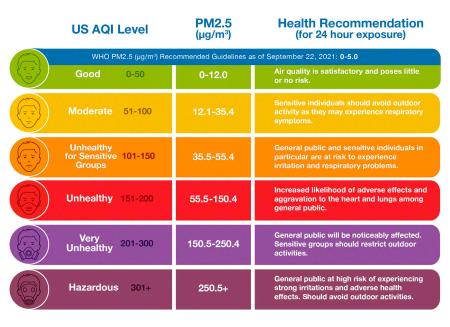Severe weather events and changing climate are contributing to many challenges for summer camps. The summer of 2023 presented new obstacles for traditional outdoor camp activities due to an onslaught of wildfires (mostly in Canada). Many camps in northern states and on the East Coast, from northern Illinois to Maine, were forced to grapple with a season of fluctuating air quality.
Camps may be asking themselves, “Was last year just a fluke? Is it really worth thinking about and planning for an increase in summer wildfire repercussions? How likely are such fires going to be in future summers? Does it really matter?”
According to the World Health Organization, wildfires not only are expected to increase because of climate change, but they also cause a significant decrease in air quality and therefore represent a major health risk. “Wildfire smoke is a mixture of air pollutants of which particulate matter (PM) is the principal public health threat. PM from wildfire smoke is associated with premature deaths in the general population, and can cause and exacerbate diseases of the lungs, heart, brain/nervous system, skin, gut, kidney, eyes, nose, and liver. It has also been shown to lead to cognitive impairment and memory loss” (World Health Organization, n.d.).
Clearly these are health risks that should not be ignored, and with the expected increase of such natural disasters, camps must be on alert.
In order for camps to prepare appropriate contingency plans for outdoor activities in the event of poor air quality, it is necessary to understand the breakdown of how air quality is evaluated. It is generally measured by the amount of particulate matter (PM) found in the air itself. Particulates found in wildfire smoke — and thus in the air — consist of nitrous oxide, aromatic hydrocarbons, and even lead (World Health Organization, n.d.). PM is broken down to a range of numbers that correlate to specific risks for varying groups, as shown in the following Air Quality Index (AQI):

This chart is easy to use and can help guide your decision-making regarding camp activities when an increase in harmful PM occurs. In general, once the AQI rises above 35, certain individuals may need to alter their outdoor activity schedules, and once the AQI goes above 55, it is time to act for the entire camp community’s well-being.
During the summer of 2023, many Eastern states from Pennsylvania to Maine experienced AQIs above 55 for multiple summer days, even weeks. Some of the hardest-hit areas experienced increases in the 150–300 PM range during the worst of the wildfire smoke. Values in this range are especially concerning, and commonly warrant indoor-only activities.
Camps should include air quality plans in their summer protocols and procedures. Use an AQI chart to guide activity tolerance starting with your vulnerable populations and working toward all-camp activity modification, if necessary. These plans should be clear, communicated to camp families, and include indoor spaces with the capability to use ventilation fans and close windows. Campers who are sensitive to poor air quality or who have been diagnosed with asthma should be moved indoors sooner, and health centers should establish strong asthma action plans with healthcare providers and families.
Camp directors should take an active role in monitoring air quality alerts during the camp season. Use the WHO, CDC, and/or applications such as The Weather Channel to review the current AQI, and act accordingly when the values rise into the danger zone. In addition, identify ventilated indoor spaces that use fans and filters to move air but do not require windows to be open. Finally, if the AQI ranges rise above the 100+ mark, camps should consider whether it is necessary to utilize outdoor masking with Kn95s to reduce the inhalation of particulate matter.
As with all camp action plans, think through the possibilities, monitor local news for air quality reports as well as fires in your area or affecting your airspace, and communicate clearly with your camp families to ensure a successful, healthy, and happy summer.
References
- IQAir. (n.d.). What is the Air Quality Index (AQI)? iqair.com/us/newsroom/what-is-aqi
- World Health Organization. (n.d.). Wildfires. who.int/health-topics/wildfires#tab=tab_1
Jane Glazer, MSN, MA, CPNP, FNP-BC, has practiced in urgent care, college health, and residential camp health. She is interested in education, evidence-based best practices, and providing care to campers in a safe and fun way.



